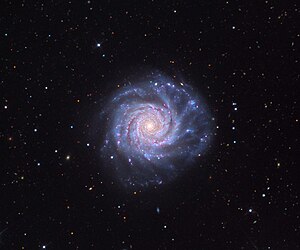NGC 3938
| Galaxy NGC 3938 |
|
|---|---|

|
|
| The galaxy NGC 3938 captured with the 81 cm reflecting telescope of the Mount Lemmon Observatory . | |
| AladinLite | |
| Constellation | Big Bear |
|
Position equinox : J2000.0 , epoch : J2000.0 |
|
| Right ascension | 11 h 52 m 49.45 s |
| declination | + 44 ° 07 ′ 14.6 ″ |
| Appearance | |
| Morphological type | SA (s) c / HII |
| Brightness (visual) | 10.1 mag |
| Brightness (B-band) | 10.8 mag |
| Angular expansion | 5.4 ′ × 4.9 ′ |
| Position angle | 0 ° |
| Surface brightness | 13.5 mag / arcmin² |
| Physical data | |
| Affiliation | Ursa Major Galaxy Clusters NGC 4051 Group LGG 269 |
| Redshift | 0.002699 ± 0.000013 |
| Radial velocity | (809 ± 4) km / s |
|
Stroke distance v rad / H 0 |
(38 ± 3) x 10 6 ly (11.6 ± 0.8) Mpc |
| history | |
| discovery | W. Herschel |
| Discovery date | February 6, 1788 |
| Catalog names | |
| NGC 3938 • UGC 6856 • PGC 37229 • CGCG 214-034 • MCG + 07-25-001 • IRAS 11502 + 4423 • 2MASX J11524945 + 4407146 • GC 2597 • H I 203 • h 1002 • LDCE 0867 NED044 • NSA 140384 • WISEA J115249.43 + 440714.8 | |
NGC 3938 is a spiral galaxy of Hubble type Sc in the constellation Ursa Major at the northern sky . It is estimated to be 38 million light-years from the Milky Way and about 94,000 light-years across. It is part of the Ursa Major Galaxy Cluster and a member of the NGC 4051 group ( LGG 269 ).
The supernovae SN 1961U (Type IIL), SN 1964L (Type Ic), SN 2005ay (Type IIP) and SN 2017ein (Type Ic) were observed here.
The object was discovered on February 6, 1788 by the German-British astronomer Wilhelm Herschel .
Web links
- SIMBAD Astronomical Database
- Aladin Lite
- Spektrum .de: amateur recordings [1]
